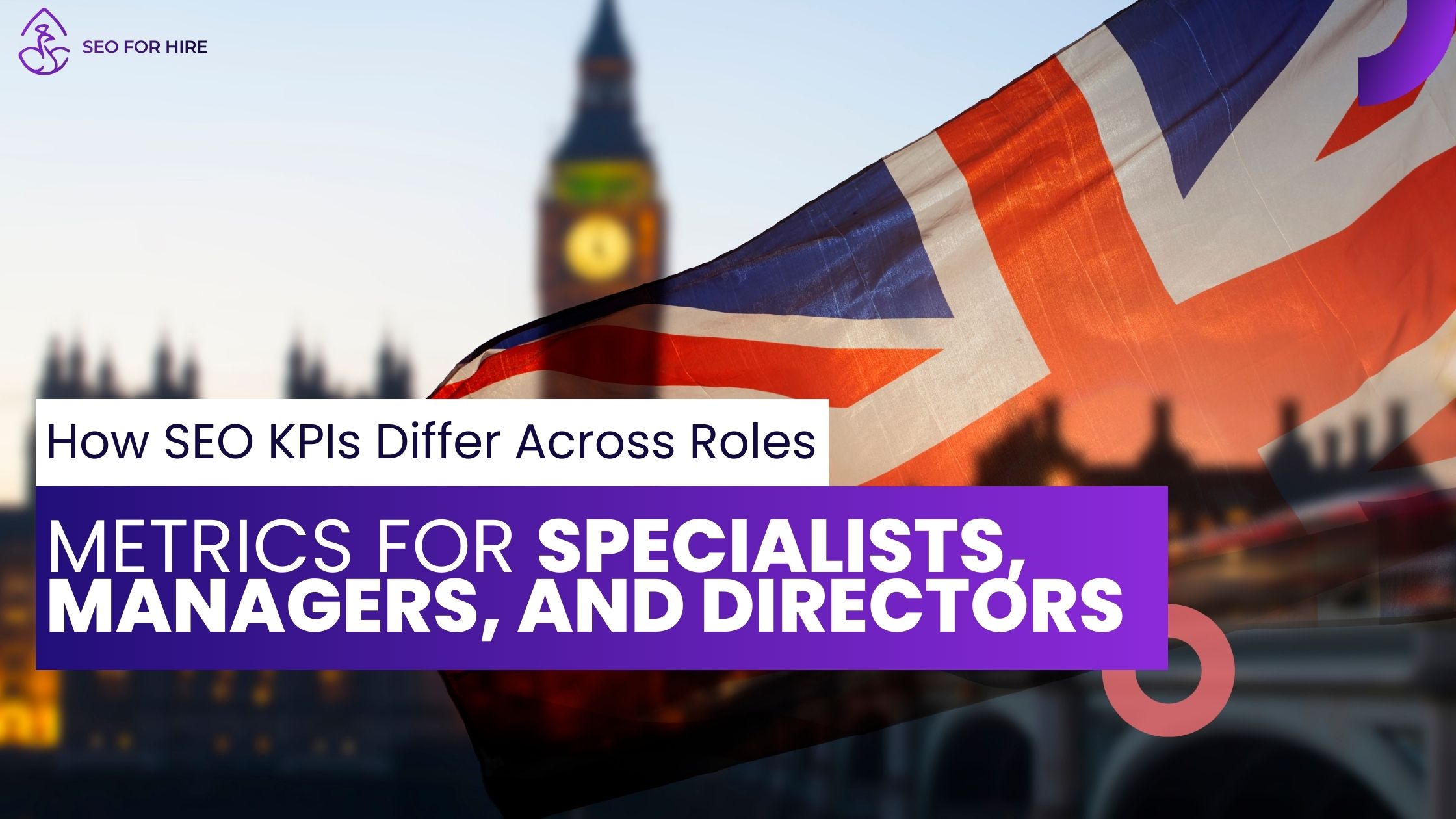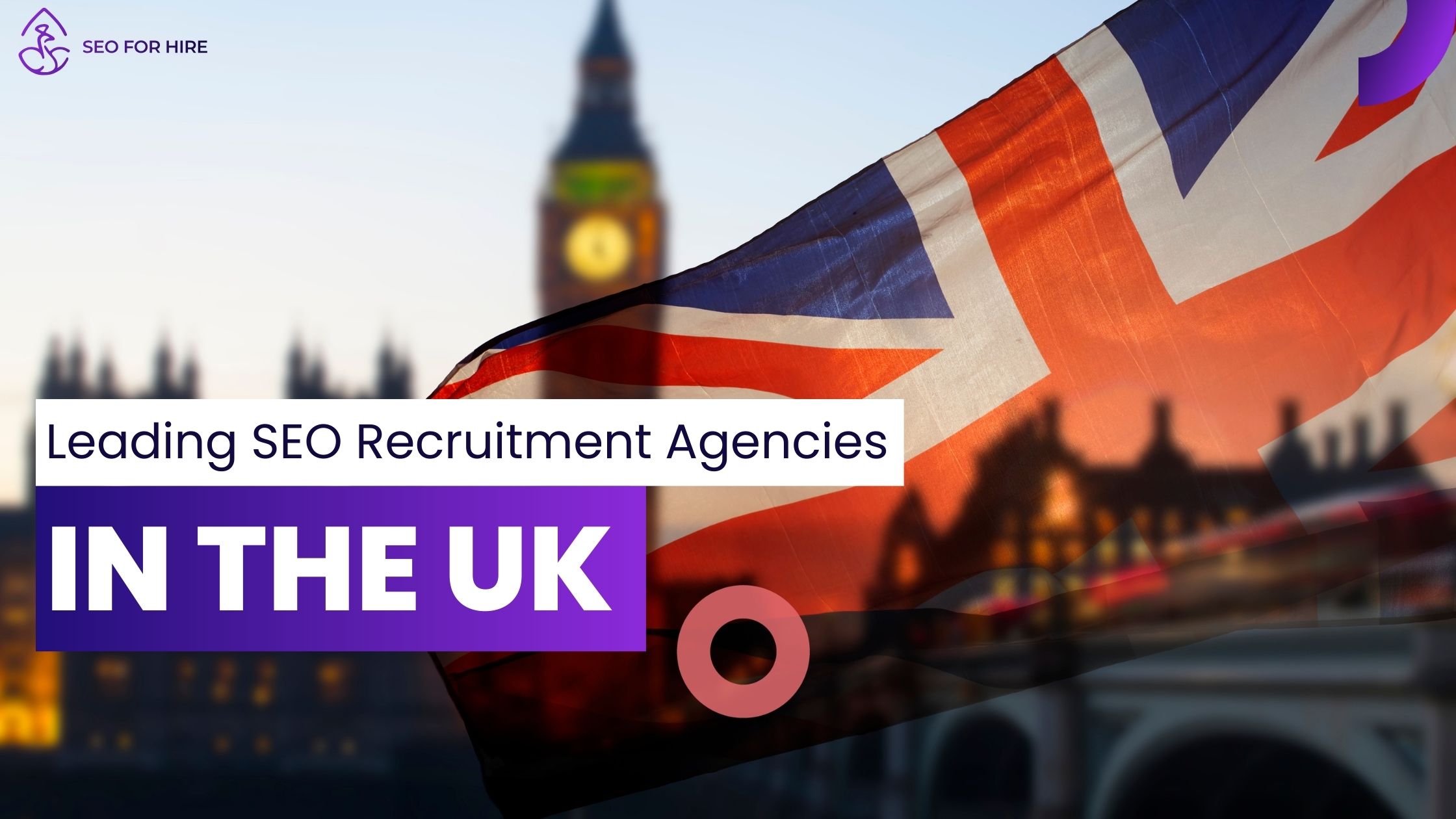TLDR;
Digital PR (DPR) has evolved from basic link-building into a key driver of SEO success, authority, and revenue.
Integration is essential: at JBH, SEO insights (keywords, audience data) shape PR campaigns from the start.
Case studies prove ROI: campaigns have delivered >100% revenue uplifts through strategic coverage and link placement.
What matters in 2025: quality signals (brand mentions, citations, share of search) outweigh sheer link volume.
Future-proofing SEO: DPR ensures brands are cited in authoritative sources so AI-driven search surfaces them as trusted answers.
Key Takeaways
Digital PR and SEO are no longer separate. Campaigns must be built with both journalist appeal and search visibility in mind from the start.
Authority beats volume. Google now rewards expertise, trust, and credibility over raw link counts.
Integration drives ROI. SEO keyword insights fuel PR storytelling, ensuring campaigns move rankings, traffic, and revenue — not just coverage.
Measurement has matured. Success is proven through rankings, share of search, organic growth, and conversion impact, not vanity metrics.
AI raises the stakes. As generative search reshapes discovery, DPR ensures brands are cited in authoritative spaces so they surface as trusted answers.
Future-ready brands will win. Companies embedding DPR into their SEO strategy will own visibility, reputation, and revenue growth in 2025 and beyond.
The SEO Strategy You’re Probably Underusing: Digital PR
“Digital PR is less about coverage for coverage’s sake, and more about orchestrating authority signals that directly feed into search visibility.”
— Rebecca Moss, Digital PR Director, JBH
SEO isn’t what it used to be, and that’s a good thing.
The playbook has evolved. Rankings no longer hinge solely on keywords and backlinks.
Today, search visibility is earned through authority, credibility, and consistent brand presence, which is exactly where Digital PR (DPR) shines.
To break down how DPR is reshaping SEO strategy, we spoke with Rebecca Moss, Digital PR Director at JBH, a UK-based agency leading the charge in integrated SEO + PR campaigns.
Rebecca presses in on how DPR has evolved, how JBH measures its real impact, and what the future holds as AI begins to reshape both discovery and authority:
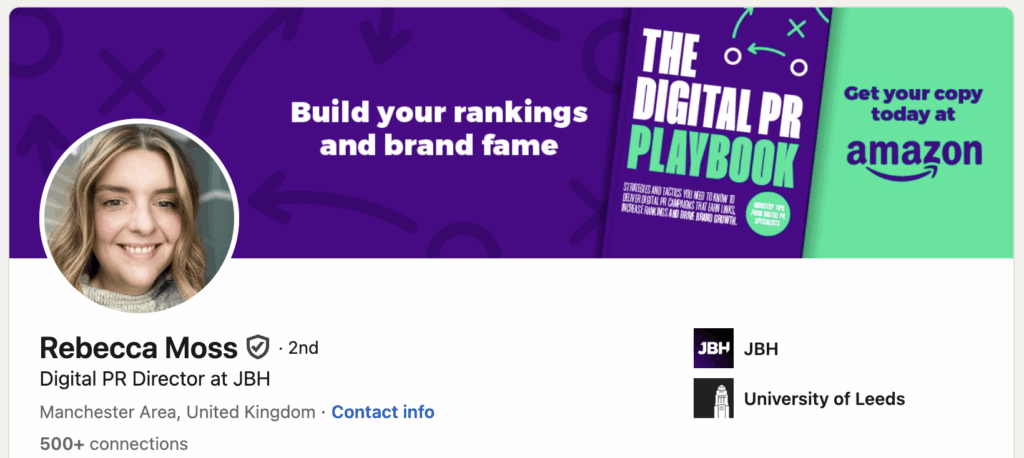
“The relationship between digital PR and SEO is more involved than it ever has been before.
Obviously, links and brand mentions remain a critical part of digital PR activity, but Google’s algorithm (including AI Mode) means that quality, relevance, authority, and trust are even more important.
I see DPR becoming less about “coverage for coverage’s sake” and more about orchestrating authority signals that feed directly into a brand’s search visibility. In practice, this means journalists, keywords, and Google’s E-E-A-T framework are (or should be) considered together from the start.”
How Has Digital PR Evolved Over the Years?
Phase 1: Link Building, Lightly Dressed (2010–2014)
Early DPR was about quantity. Think: infographics and generic press releases pitched for backlinks.
DPR meant churning out infographics and pitching them to publishers for backlinks. It was tactical, siloed, and often disconnected from wider SEO goals. At the time, that was enough, links equaled rankings.
It worked, until Google caught on.
Cue: Penguin update and the death of spammy link schemes.
Phase 2: Content Gets Creative (2015–2018)
Agencies pivoted to data-driven content, interactive tools, and storytelling. SEO and PR teams started collaborating, but integration was still patchy.
By 2015–2018, the most forward-thinking agencies had moved beyond infographics.
Digital PR became more creative, with data-driven studies, interactive tools, and narrative campaigns that earned links and delivered on business objectives. SEO and PR teams began working closer, but integration was still inconsistent.
Phase 3: Authority, Not Just Attention (2019–Present)
Fast forward to 2025, and DPR has matured into something much more strategic. According to Rebecca:
“Digital PR is less about ‘coverage for coverage’s sake’ and more about orchestrating authority signals that directly feed into search visibility.”
This means DPR campaigns today must satisfy two demanding audiences at once:
- Journalists: who want relevance, novelty, and credible data.
- Google: which rewards expertise, experience, authority, and trust.
“Over the past five years at JBH, we’ve deliberately broken down the silos between SEO and PR.
Early on, our digital PR campaigns might have been designed to “get coverage” and only afterwards did we ask how that helped SEO or business objectives.
Today, we design campaigns with SEO and GEO objectives right from the start.
We started aligning PR campaigns with SEO objectives about five years ago, when we realised that clients weren’t satisfied with press coverage alone. They wanted to see impact on rankings and traffic and even prove the ROI in their investment with us.
Now the teams are tightly integrated: SEOs feed us keyword insights, and the digital PR team uses those insights to drive the ideas and creative strategy forwards.”
Today, DPR is a core SEO driver, not an afterthought. At JBH, SEO and PR operate as a single unit to build trust signals that Google can’t ignore.
Rebecca adds that Google’s algorithm changes have accelerated this.
“We can’t get away with surface-level link acquisition; every campaign now has to demonstrate expertise, experience, authority, and trust. That means more thought leadership, founder-led insights, and original data that journalists and algorithms can use.”
Why Shouldn’t SEO and PR Teams Work Separately Anymore?
JBH made the shift five years ago.
“Clients wanted proof that coverage impacted rankings and traffic,” says Rebecca. “So we started baking SEO goals into every PR campaign from the start.”
Now, every DPR campaign starts with SEO insights, keyword gaps, SERP analysis, audience data, and ends with measurable results across rankings, traffic, and revenue.
PR teams then build journalist-ready stories around those insights, ensuring campaigns are both media-worthy and search-friendly.
This tight integration means DPR campaigns aren’t just a “bolt-on” for link equity, but a driver of measurable business outcomes.
The JBH Playbook: What Integrated DPR + SEO Looks Like
Rebecca outlines the JBH playbook in practice.
“When we build campaigns, we ask: does this reinforce the brand’s authority in its space? Is the data credible, does the client have proper experience in their area, or unique insights?
That framing means when coverage lands, it does more than generate links it elevates the brand’s expertise.”
This is then followed by:
- SEO identifies opportunities: keywords, SERP gaps, competitive signals
- PR builds campaigns: rooted in data, expert input, or trend relevance
- Content gets optimized: entity-rich, evergreen, and keyword-aligned
- Outreach targets quality media: niche, national, and high-authority
- Results get tracked: not just links, but rankings, conversions, and revenue
This integration allows campaigns to achieve dual wins: landing in the press while strengthening the brand’s footprint in organic search.
Rebecca adds to this,
“Balancing journalist appeal with SEO is tricky, but doable. Journalists want novelty, relevance, and simplicity.
SEO needs entity-rich, keyword-aligned assets. We create assets that work for both: for example, data-led studies presented in visual, shareable formats that are relevant to key, revenue driving category or product pages.”
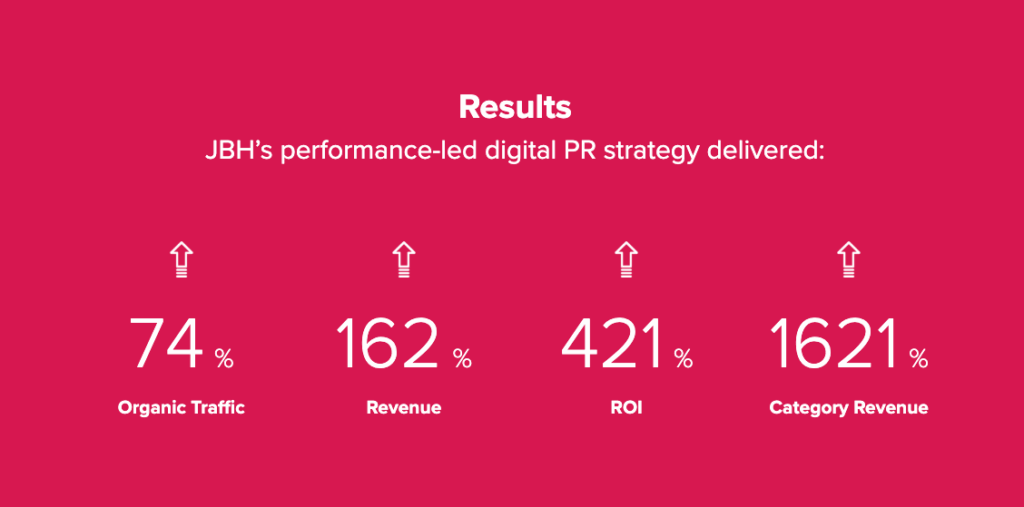
Proving ROI: From Coverage to Conversions
One of the biggest criticisms of PR historically was its “soft” metrics. DPR changed that.
JBH proves ROI by linking campaigns to tangible SEO and commercial outcomes.
- Personal Finance Brand:
DPR campaign aligned with commercial keywords →
+60% revenue growth | +25% ROI
- Cosmetics Comparison Site:
58% of links landed on key category page →
+74% organic traffic | +162% revenue growth
The message is clear:
DPR is not a vanity exercise. Done right, it can move rankings, traffic, and revenue.
Rebecca offered the synergetic approach by the DPR and SEO teams to brainstorm together, share keyword research, and coordinate campaign timelines to fit around business needs like product launches or another big marketing moment, adding:
“ROI proof is key. We track not just coverage and links, but also movement in rankings, traffic growth, and in some cases conversion uplift.”
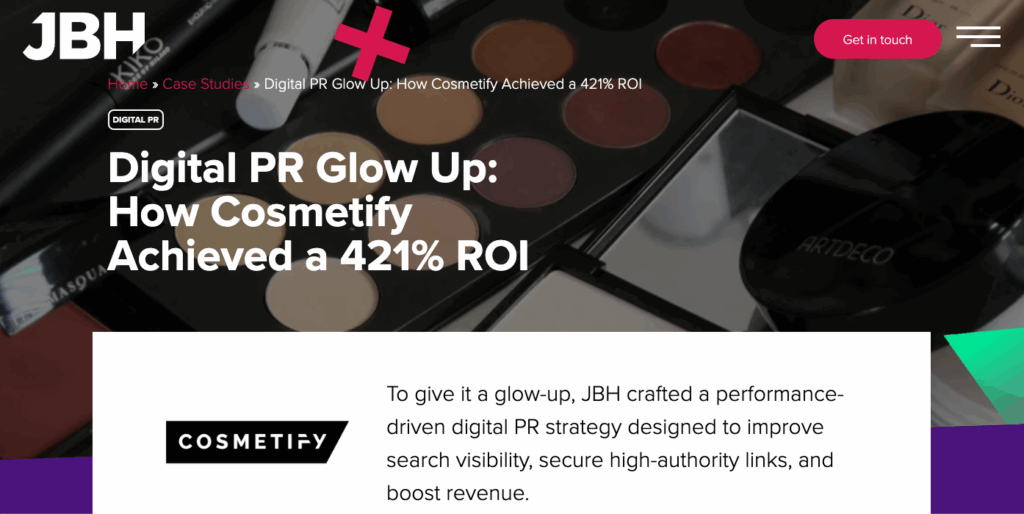
What Trust Signals Matter Most in 2025?
As Google shifts from quantity of links to quality of authority, JBH recalibrated its approach. Today’s DPR campaigns focus on generating a mix of signals:
- High-quality backlinks from credible publications.
- Brand mentions that reinforce authority.
- Reputation signals like reviews and expert commentary.
- Citations and references in sector-specific outlets.
- Share of search, measured against competitors.
Rebecca explains:
“As Google pivots from link quantity to authority and trust, we’ve recalibrated our outreach.
Instead of scattergun link chasing, we prioritise placements that reinforce brand authority, whether that’s sector-specific publications, data-driven national coverage, or reputation-building thought leadership.
The signals we focus on in 2025 are links, brand mentions, reputation signals, citations, and share of search.
How often does this brand show up in credible spaces? Do they own the conversation around their core keyword terms?
If not, how can we work to improve this.”
Lessons for SEOs and PRs
Rebecca had one message for each discipline:
- For SEOs:
“DPR isn’t just about earning links to satisfy a ‘cost-per-link’ target, it’s about shaping brand authority, which in turn feeds ranking improvements, but also feeds brand reputation which is more important than ever, especially where AI overviews and LLM search is concerned.”
- For DPRs:
“SEO isn’t just about keywords and tweaking copy on a page; it’s about understanding how your PR campaigns improve organic performance, not just generate press cuttings.”
This mutual understanding is critical as AI changes how people find information.
The Future of DPR in an AI-First World
Rececca highlights how Generative AI and Search Generative Experience (SGE) are changing how brands are discovered. In the next 3–5 years, DPR will shift even more toward brand positioning in authoritative sources.
“If AI is curating and surfacing answers, then DPR must ensure the brand is consistently visible, authoritative, and trusted in the cited sources.”
That means, she adds, that more focus will rely on entity-rich off-page content, featured in the right publications so that AI systems can interpret and show our clients for the right prompts.
“DPR will be less about chasing follow or no-follow links, and more about embedding brands properly so that whether a person or an AI assistant asks the question, our clients show up as the trusted source.”
This requires entity-rich content placed in publications that both humans and AI recognise as authoritative. DPR will be less about chasing volume and more about building search-ready reputations.
Final Summary
Digital PR has grown up, and it’s now one of the most powerful SEO tools available.
Agencies that integrate PR and SEO aren’t just getting better press. They’re building authority-rich search visibility, earning trust signals that AI will surface again and again, and tying campaigns directly to revenue.
In an AI-first future, if your brand isn’t trusted, it’s invisible.
FAQs: How to Apply Digital PR Insights
Why should SEOs care about digital PR?
Because Google now values authority signals (E-E-A-T) as much as technical optimisation. DPR campaigns provide high-quality backlinks, brand mentions, and citations that strengthen a site’s trustworthiness and directly influence rankings.
How can SEOs integrate DPR into their workflow?
Start by feeding keyword research and content gaps to PR teams. Ensure every campaign idea aligns with search intent and commercial pages. Treat DPR not as a silo but as part of your SEO strategy.
What’s the biggest mistake SEOs make with digital PR?
Chasing cost-per-link efficiency rather than thinking about authority building. A link on a high-authority, relevant publication is worth more than dozens of weaker placements.
How do SEOs prove the ROI of digital PR to clients or stakeholders?
Don’t stop at “coverage reports.” Show movement in rankings, share of search, organic traffic, and conversions. Where possible, tie DPR campaigns to revenue outcomes, not just link counts.
What can SEOs learn from JBH’s approach?
Break down silos between PR and SEO early.
Use keyword insights to shape campaigns, not just evaluate them afterwards.
Focus on data-led, thought-leadership assets that appeal to both journalists and algorithms.
Measure success beyond links — include share of search, conversions, and brand authority.
Will AI make link-building obsolete?
No — but it will change the game. In an AI-driven search landscape, brands consistently cited in authoritative sources will dominate visibility. For SEOs, that means DPR isn’t optional — it’s the foundation of being “AI-ready.”
Need to Hire SEO Talent?
Contact SEO For Hire to connect with pre-vetted SEO professionals across the UK.
About SEO for Hire
At SEO for Hire, we help agencies hire the right SEO talent faster and with less risk. Our placements are powered by scorecards, proprietary salary data, and backed with a 1-year satisfaction guarantee.
We’ve helped agencies like Rankings.io, Single Grain, and Sokratic build teams that deliver measurable ROI.

